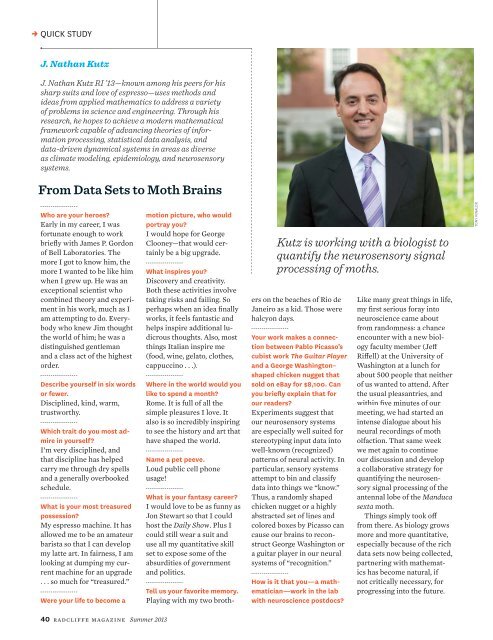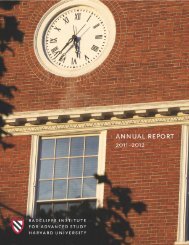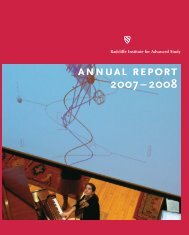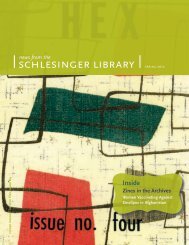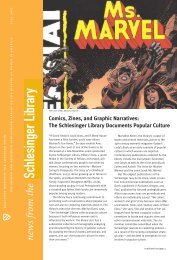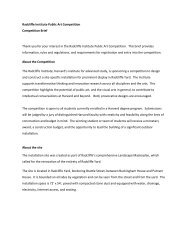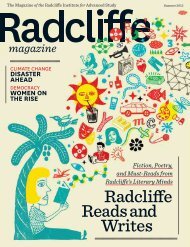Download - Radcliffe Institute for Advanced Study - Harvard University
Download - Radcliffe Institute for Advanced Study - Harvard University
Download - Radcliffe Institute for Advanced Study - Harvard University
Create successful ePaper yourself
Turn your PDF publications into a flip-book with our unique Google optimized e-Paper software.
V QUICK STUDY<br />
J. Nathan Kutz<br />
J. Nathan Kutz RI ’13—known among his peers <strong>for</strong> his<br />
sharp suits and love of espresso—uses methods and<br />
ideas from applied mathematics to address a variety<br />
of problems in science and engineering. Through his<br />
research, he hopes to achieve a modern mathematical<br />
framework capable of advancing theories of in<strong>for</strong>mation<br />
processing, statistical data analysis, and<br />
data-driven dynamical systems in areas as diverse<br />
as climate modeling, epidemiology, and neurosensory<br />
systems.<br />
From Data Sets to Moth Brains<br />
Who are your heroes<br />
Early in my career, I was<br />
<strong>for</strong>tunate enough to work<br />
briefly with James P. Gordon<br />
of Bell Laboratories. The<br />
more I got to know him, the<br />
more I wanted to be like him<br />
when I grew up. He was an<br />
exceptional scientist who<br />
combined theory and experiment<br />
in his work, much as I<br />
am attempting to do. Everybody<br />
who knew Jim thought<br />
the world of him; he was a<br />
distinguished gentleman<br />
and a class act of the highest<br />
order.<br />
Describe yourself in six words<br />
or fewer.<br />
Disciplined, kind, warm,<br />
trustworthy.<br />
Which trait do you most admire<br />
in yourself<br />
I’m very disciplined, and<br />
that discipline has helped<br />
carry me through dry spells<br />
and a generally overbooked<br />
schedule.<br />
What is your most treasured<br />
possession<br />
My espresso machine. It has<br />
allowed me to be an amateur<br />
barista so that I can develop<br />
my latte art. In fairness, I am<br />
looking at dumping my current<br />
machine <strong>for</strong> an upgrade<br />
. . . so much <strong>for</strong> “treasured.”<br />
Were your life to become a<br />
motion picture, who would<br />
portray you<br />
I would hope <strong>for</strong> George<br />
Clooney—that would certainly<br />
be a big upgrade.<br />
What inspires you<br />
Discovery and creativity.<br />
Both these activities involve<br />
taking risks and failing. So<br />
perhaps when an idea finally<br />
works, it feels fantastic and<br />
helps inspire additional ludicrous<br />
thoughts. Also, most<br />
things Italian inspire me<br />
(food, wine, gelato, clothes,<br />
cappuccino . . .).<br />
Where in the world would you<br />
like to spend a month<br />
Rome. It is full of all the<br />
simple pleasures I love. It<br />
also is so incredibly inspiring<br />
to see the history and art that<br />
have shaped the world.<br />
Name a pet peeve.<br />
Loud public cell phone<br />
usage!<br />
What is your fantasy career<br />
I would love to be as funny as<br />
Jon Stewart so that I could<br />
host the Daily Show. Plus I<br />
could still wear a suit and<br />
use all my quantitative skill<br />
set to expose some of the<br />
absurdities of government<br />
and politics.<br />
Tell us your favorite memory.<br />
Playing with my two broth-<br />
Kutz is working with a biologist to<br />
quantify the neurosensory signal<br />
processing of moths.<br />
ers on the beaches of Rio de<br />
Janeiro as a kid. Those were<br />
halcyon days.<br />
Your work makes a connection<br />
between Pablo Picasso’s<br />
cubist work The Guitar Player<br />
and a George Washington–<br />
shaped chicken nugget that<br />
sold on eBay <strong>for</strong> $8,100. Can<br />
you briefly explain that <strong>for</strong><br />
our readers<br />
Experiments suggest that<br />
our neurosensory systems<br />
are especially well suited <strong>for</strong><br />
stereotyping input data into<br />
well-known (recognized)<br />
patterns of neural activity. In<br />
particular, sensory systems<br />
attempt to bin and classify<br />
data into things we “know.”<br />
Thus, a randomly shaped<br />
chicken nugget or a highly<br />
abstracted set of lines and<br />
colored boxes by Picasso can<br />
cause our brains to reconstruct<br />
George Washington or<br />
a guitar player in our neural<br />
systems of “recognition.”<br />
How is it that you—a mathematician—work<br />
in the lab<br />
with neuroscience postdocs<br />
Like many great things in life,<br />
my first serious <strong>for</strong>ay into<br />
neuroscience came about<br />
from randomness: a chance<br />
encounter with a new biology<br />
faculty member (Jeff<br />
Riffell) at the <strong>University</strong> of<br />
Washington at a lunch <strong>for</strong><br />
about 500 people that neither<br />
of us wanted to attend. After<br />
the usual pleasantries, and<br />
within five minutes of our<br />
meeting, we had started an<br />
intense dialogue about his<br />
neural recordings of moth<br />
olfaction. That same week<br />
we met again to continue<br />
our discussion and develop<br />
a collaborative strategy <strong>for</strong><br />
quantifying the neurosensory<br />
signal processing of the<br />
antennal lobe of the Manduca<br />
sexta moth.<br />
Things simply took off<br />
from there. As biology grows<br />
more and more quantitative,<br />
especially because of the rich<br />
data sets now being collected,<br />
partnering with mathematics<br />
has become natural, if<br />
not critically necessary, <strong>for</strong><br />
progressing into the future.<br />
TONY RINALDO<br />
40 radcliffe magazine Summer 2013


